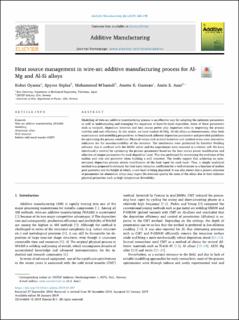| dc.contributor.author | Oyama, Kohei | |
| dc.contributor.author | Diplas, Spyridon | |
| dc.contributor.author | M'hamdi, Mohammed | |
| dc.contributor.author | Gunnæs, Anette Eleonora | |
| dc.contributor.author | S. Azar, Amin | |
| dc.date.accessioned | 2020-05-07T09:37:00Z | |
| dc.date.available | 2020-05-07T09:37:00Z | |
| dc.date.created | 2019-04-17T10:20:19Z | |
| dc.date.issued | 2019 | |
| dc.identifier.citation | Additive Manufacturing. 2019, 26 180-192. | en_US |
| dc.identifier.issn | 2214-8604 | |
| dc.identifier.uri | https://hdl.handle.net/11250/2653605 | |
| dc.description.abstract | Modelling of wire-arc additive manufacturing process is an effective way for adapting the optimum parameters as well as understanding and managing the sequences of layer-by-layer deposition. Some of these parameters such as toolpath, deposition intervals and heat source power play important roles in improving the process viability and cost efficiency. In this article, we have studied Al-5Mg, Al-3Si alloys as demonstrators, from both experimental and modelling perspectives, to benchmark different deposition parameters and provided guidelines for optimising the process conditions. Physical values such as total distortion and residual stress were selected as indicators for the manufacturability of the structure. The simulations were performed by Simufact Welding software, that is outfitted with the MARC solver and the experiments were executed in a robotic cell. We have introduced a method for optimising the process parameters based on the heat source power modification and selection of unique parameters for each deposition layer. This was performed by monitoring the evolution of the molten pool size and geometry when building a wall structure. The results suggest that achieving an uninterrupted deposition process entails modification of the heat input for each layer. Thus, a simple analytical method was proposed to estimate the heat input reduction coefficient for a wall structure as a function of molten pool geometry and the height at which, a new layer is being deposited. It was also shown that a generic selection of parameters for aluminium alloys may impair the eventual quality for some of the alloys due to their inherent physical properties such as high temperature flowability. | en_US |
| dc.language.iso | eng | en_US |
| dc.publisher | Elsevier | en_US |
| dc.rights | Navngivelse 4.0 Internasjonal | * |
| dc.rights.uri | http://creativecommons.org/licenses/by/4.0/deed.no | * |
| dc.subject | Wire-arc additive manufacturing | en_US |
| dc.subject | Aluminium alloys | en_US |
| dc.subject | Wall structure | en_US |
| dc.subject | Robotic cold metal transfer | en_US |
| dc.title | Heat source management in wire-arc additive manufacturing process for Al-Mg and Al-Si alloys | en_US |
| dc.type | Journal article | en_US |
| dc.type | Peer reviewed | en_US |
| dc.description.version | publishedVersion | en_US |
| dc.rights.holder | Under a Creative Commons license https://creativecommons.org/licenses/by/4.0/ | en_US |
| dc.source.pagenumber | 180-192 | en_US |
| dc.source.volume | 26 | en_US |
| dc.source.journal | Additive Manufacturing | en_US |
| dc.identifier.doi | 10.1016/j.addma.2019.01.007 | |
| dc.identifier.cristin | 1693037 | |
| cristin.unitcode | 7401,80,62,0 | |
| cristin.unitcode | 7401,80,63,0 | |
| cristin.unitname | Bærekraftig energiteknologi | |
| cristin.unitname | Metallproduksjon og prosessering | |
| cristin.ispublished | true | |
| cristin.fulltext | original | |
| cristin.qualitycode | 1 | |

